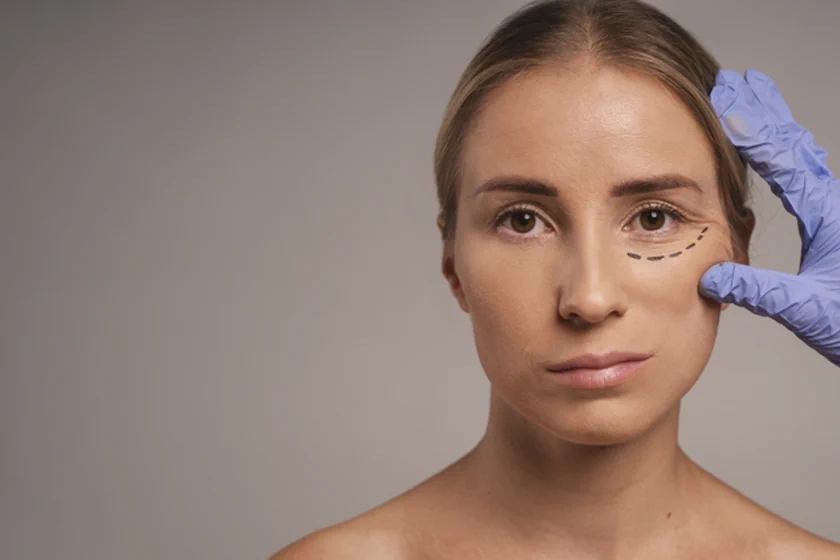|
Getting your Trinity Audio player ready...
|
An eyelid infection might seem like a small issue, but it can significantly impact your comfort and daily life.
From repeated episodes of itching and swelling to more severe complications, understanding and treating eyelid infections is crucial. In this guide, we’ll dive deep into the causes, symptoms, types, and treatments of eyelid infections.
Whether you’re dealing with an infection yourself or just curious, this comprehensive guide will help you navigate the issue with ease.
What is an Eyelid Infection?
An eyelid infection can affect various parts, including the skin, the glands, the hair follicles and the inner lining.
This condition can be caused by bacteria, viruses, or even parasites, leading to a range of symptoms that can make daily activities uncomfortable.
The infection may involve the external skin of the eyelid, the hair follicles or deeper structures like the meibomian glands, which produce the oily component of tears.
Causes of Eyelid Infections
Understanding the causes of eyelid infections can help you prevent and treat them more effectively. Here are the primary culprits:
Bacterial Infections: The most common cause of eyelid infections. Bacteria such as Staphylococcus aureus and Streptococcus species are often responsible. These bacteria can infect the eyelid when they enter through small cuts or abrasions, or from poor hygiene practices.
Viral Infections: Viruses like the herpes simplex virus can lead to more serious conditions, such as herpetic keratitis. This type of infection often results from direct contact with an infected individual or contaminated objects.
Parasites: Demodex mites are tiny parasites that live on the skin and can sometimes cause infections when they proliferate excessively. These mites are normally harmless but can lead to inflammation if their numbers become too high.
Blocked Glands: Blockage of the meibomian glands (which are responsible for producing the oily layer of the tear film) can lead to conditions like styes and chalazia. These blockages can become infected, causing inflammation and discomfort.
Eyelid Infection Symptoms
The symptoms of an eyelid infection can vary based on the infection type and severity, but common signs include:
- Redness: The eyelid may appear pink or red due to inflammation and increased blood flow.
- Swelling: A swollen eyelid can make it difficult to open your eye fully and may be accompanied by tenderness.
- Pain: Discomfort around the eye is common, ranging from mild irritation to severe pain.
- Discharge: The presence of yellow, green, or clear discharge can indicate an infection. This discharge might crust around the eye or eyelid.
- Itching/Burning: An itchy or burning sensation is often associated with infections and inflammation.
- Sensitivity to Light: Increased sensitivity to light can occur, especially in more severe cases.
- Blurry Vision: In cases where the infection affects the cornea or causes significant swelling, blurry vision may be experienced.
Types of Eyelid Infections
Different types of eyelid infections have distinct characteristics and treatment approaches. Here are the most common types:
Stye (Hordeolum): A stye is a painful, red lump on the eyelid that results from an infection of a meibomian gland or an eyelash follicle. It often starts as a small pimple-like bump and can develop into a larger, more painful lump. Styes are usually caused by bacterial infections, particularly Staphylococcus aureus.
Chalazion: A chalazion is a non-infectious lump that occurs when a meibomian gland becomes blocked. Unlike styes, chalazia are not typically painful but can cause swelling and discomfort. If infected, however, a chalazion can become inflamed and resemble a stye.
Blepharitis: This is an inflammation of the eyelid margins, often caused by bacterial infections or seborrheic dermatitis. Symptoms include redness, itching, and crusting around the eyelid.
Conjunctivitis (Pink Eye): Although not exclusive to the eyelid, conjunctivitis can affect the eyelids and cause symptoms such as redness, itching, and discharge. It can be caused by bacteria, viruses, or allergens.
Risk Factors for Eyelid Infections
Certain factors can increase your likelihood of developing an eyelid infection:
- Poor Hygiene: Inadequate hand washing and touching your eyes with unclean hands can introduce bacteria and other pathogens.
- Contact Lens Use: Improper handling or cleaning of contact lenses can lead to infections.
- Existing Eye Conditions: Conditions such as blepharitis or meibomian gland dysfunction can predispose you to infections.
- Weakened Immune System: Individuals with weakened immune systems are more susceptible to infections of all kinds, including those affecting the eyelids.
- Environmental Factors: Exposure to pollutants, allergens, or excessive dust can irritate the eyes and increase the risk of infection.
Diagnosis of Eyelid Infections
Diagnosing an eyelid infection typically involves a thorough examination by an eye specialist. Here’s how it’s usually done:
- Medical History: Your doctor will ask about your symptoms, recent exposure to potential irritants or infectious agents, and any existing medical conditions.
- Physical Examination: A detailed examination of the eyelid and surrounding areas will be conducted. The doctor will look for signs of swelling, redness, and discharge.
- Lab Tests: In some cases, your doctor may take a sample of the discharge for laboratory analysis to identify the causative agent (bacteria, virus, or fungus).
Treatment of Eyelid Infections
Treatment depends on the type and severity of the infection. Here are common treatment options:
Warm Compresses: Applying a warm, moist cloth to the affected eyelid can help reduce swelling, relieve discomfort, and promote drainage of any pus or fluid. This is often recommended for styes and chalazia.
Antibiotic Ointments or Drops: For bacterial infections, topical antibiotics may be prescribed to target the specific bacteria causing the infection. It’s essential to follow the doctor’s instructions and complete the full course of medication.
Oral Antibiotics: In more severe cases or if the infection doesn’t respond to topical treatments, oral antibiotics may be necessary.
Antiviral Medications: For viral infections like herpetic keratitis, antiviral medications may be prescribed to help manage the virus and reduce symptoms.
Anti-inflammatory Medications: Over-the-counter or prescription anti-inflammatory medications can help reduce swelling and pain.
Surgical Intervention: In cases where a chalazion becomes persistently inflamed or a stye does not drain properly, minor surgical procedures might be required to remove the blockage or infected tissue.
Good Hygiene Practices: Maintaining proper hygiene is crucial in managing and preventing eyelid infections. This includes cleaning your eyelids gently with prescribed cleansers and avoiding touching or rubbing your eyes with dirty hands.
Prevention of Eyelid Infections
Preventing eyelid infections involves adopting good habits and maintaining eye health. Here are some tips:
- Practice Good Hygiene: Wash your hands regularly and avoid touching your eyes with unclean hands.
- Proper Contact Lens Care: Follow all recommended guidelines for cleaning and storing contact lenses.
- Avoid Sharing Eye Makeup: Sharing eye makeup can spread infections, so use your own products and replace them regularly.
- Manage Existing Conditions: Address and manage conditions like blepharitis or meibomian gland dysfunction to prevent secondary infections.
- Regular Eye Check-ups: Regular visits to an eye specialist can help detect and address any potential issues before they develop into infections.
Dr. Surbhi's Approach to Eyelid Infection Treatment
Dr. Surbhi Kapadia, the best eye specialist in Vadodara, takes a comprehensive and personalized approach to treating eyelid infections. At the best eye hospital in Vadodara, Aadicura, Dr. Kapadia emphasizes the importance of accurate diagnosis and effective treatment. Her approach includes:
- Detailed Evaluation: Dr. Kapadia conducts thorough examinations to determine the exact cause of the infection, ensuring that the treatment plan is tailored to each patient’s needs.
- Cutting-Edge Treatments: Utilizing the latest medical advancements and techniques, she provides effective treatment options to manage and resolve infections efficiently.
- Patient Education: Educating patients on proper eye hygiene and preventive measures to avoid future infections is a key component of her approach.
- Follow-Up Care: Regular follow-ups to monitor progress and ensure complete resolution of the infection are part of Dr. Kapadia’s commitment to patient care.
By following Dr. Surbhi Kapadia’s expert advice and utilizing the resources available at the best eye hospital in Vadodara, you can effectively manage and treat eyelid infections, ensuring your eyes stay healthy and comfortable.
With the right knowledge and treatment, eyelid infections don’t have to disrupt your life. Keep these tips in mind, and don’t hesitate to seek professional care if you need it. Your eyes will thank you!
FAQs About Eyelid Infection
How long does an eyelid infection take to heal?
Most mild eyelid infections start improving within a few days with proper treatment. More severe infections may take a couple of weeks to fully resolve.
Can I wear contact lenses if I have an eyelid infection?
It’s generally advised to avoid wearing contact lenses until the infection has fully cleared to prevent worsening the condition or spreading the infection.
Are there any home remedies for eyelid infections?
Warm compresses can be a helpful home remedy. However, it’s important to consult with a healthcare professional before trying home treatments, especially if symptoms persist.
When should I see a doctor for an eyelid infection?
See a doctor if you experience severe pain, vision changes, significant swelling, or if symptoms do not improve with over-the-counter treatments.
Can eyelid infections be contagious?
Some types of eyelid infections, particularly those caused by viruses or bacteria, can be contagious. It’s essential to practice good hygiene to prevent spreading the infection.
![]()






